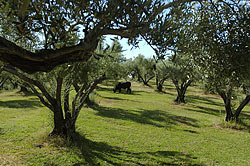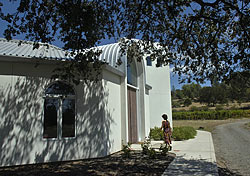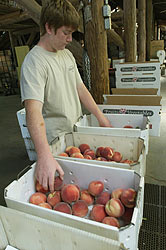
The new Sierra Oro Farm Trail in Butte County includes the Johansson olive orchard, which features a tasting room where visitors can sample the family's Lodestar olive oil.
Sacramento Bee/Jay Mather

Janice Rosene enters her Odyssey Winery and Vineyards near Chico, where a tasting room and art gallery are near completion. The Sierra Oro Farm Trail in Butte County and others throughout the state are growing in popularity as more small specialty farmers sell directly to consumers.
Sacramento Bee/Jay Mather
Harvesting tourists
Food businesses and farms map out trails to lure urban visitor
August 14, 2005
Welcome, Butte County.
Believers in agritourism are seeding the state with 30,000 maps of their new Sierra Oro Farm Trail, 90 minutes north of Sacramento, two to three hours from the Bay Area. Touting wine and olive oil tasting, handfuls of chocolate-covered almonds, apple orchards and fields of lavender, their directions point to what farmers here call "culinary adventures" and "food with a story."
At least one agricultural expert calls Sierra Oro the newest among nearly 30 farm trails in California. The trails are growing as more small specialty farmers sell directly to consumers and more urban travelers seek a quality encounter with rural food growers. Ironically, he acknowledges this direct marketing phenomenon, which includes a doubling of farmers markets across California and the nation since 1994 - to 3,706 last year - grows in direct proportion to the increasing consolidation and vertical integration inside the business of food."It's a national movement, with New England, California and Texas being in the forefront," said the agricultural expert, Desmond Jolly, director of the University of California's Small Farm Center at Davis. As thousands of Europeans seek out inns on family farms and Web sites point to farm stays in New Zealand, highway farm trails where people can buy wine, cheese and Pink Lady apples are growing more popular closer to home, in Amador, El Dorado, Calaveras, Yolo, Solano, Napa, Sonoma and Lake counties, Jolly said. Others abound on the Central Coast and attract visitors to the San Joaquin Valley.
Almost two-dozen Butte County farm and food businesses believe many Sacramentans and Bay Area residents are tired of Napa Valley wine crowds, have already seen Sonoma and may want to bring their wallets to new agricultural scenery.
"We're trying to capture a market of people who want to stay one night," said Heather Quilici, a family winery owner and chief player in the farm trail campaign.
The California Travel and Tourism Commission doesn't track agritourism, but nationally, rural sightseeing accounts for 10 percent of domestic trips and represents the fifth most significant reason for traveling, according to the Travel Industry Association of America.
Tourists spent an estimated $201.9 million in Butte County in 2003, according to state travel statistics, supporting 3,500 jobs and $3.3 million in local taxes. The county's agricultural production last year totaled $358 million, led by rice, almonds, English walnuts and dried plums.
"We want to get people into the beauty that is in the back hills," said Jamie Johansson, who farms a 40-acre stand of 90-year-old olive trees in rolling low hills near Oroville. Though the old Gold Rush town of 13,000 is better known for the Feather Falls Casino and a lake that draws 1.1 million visitors a year, Johansson and his wife, Nicole, are trying to put it on the map for a buttery-tasting olive oil, especially their award-winning family brand, Lodestar.
Last month, the couple opened a tasting room with samples of bread and olive oil dips to highlight the region's specialty, a late-harvest Mission Olive variety that came to California with Father Junipero Serra and the Franciscans who founded a chain of coastal missions.
"It's why we say this farm is food with a story. All food has a story," Jamie Johansson said.
Likewise, Maisie Jane Hurtado told a story about her teenage Future Farmers of America project that became a niche business of processing and selling family almonds traditionally sold to distributors. A fourth-generation farmer, she sells garlic-flavored and chocolate-covered nuts and almond butter out of a 1905 Chico storefront along with other local foods.
In Paradise, Jim Noble sells fruit from a 50-acre orchard as did his father and his grandfather before him, saying his Red Delicious apples still taste delicious.
"We're the last apple grower in town," he said. "Everything else is pushing up houses."
Along the quiet county roads marked by long, sweeping vistas of golden grassland and interrupted by vineyards are small new wineries named Odyssey, Quilici, Larocca, Grey Fox and Long Creek. Bed and breakfast inns and Chico restaurants have also signed onto the novel food-themed "trail" venture.
"There's always been fruit stands," said Johansson, "and the wineries have tasting rooms. Now it's expanding into all of agriculture."
Collectively, 23 members of the trail coalition paid $325 to $500 each to cover costs of 30,000 maps and other promotional materials. They believe their investments will pay off eventually with more day trips and weekend jaunts to their farms and wineries.
Johansson, Hurtado and Noble say direct sales to buyers help them keep most of the value of their farm products, a significant advantage considering their small scale. Nationally, farmers typically receive 19 percent of the value of their crops, reports the U.S. Department of Agriculture. Marketing consumes the other 81 percent.
"Larger farms produce most of the volume and value so the small farms have to scramble," Jolly said. "That means not just producing exotic and interesting niche things on the farm, but also getting off-farm income."
That's bringing more urban people directly onto farms, he said, fueling a trails fad that provides ever more options for travelers seeking entertainment and food.
"There are new ones popping up every month," Jolly said.
HITTING THE TRAILS
The Sierra Oro Farm Trail is one of many routes that showcase California's agricultural bounty. For information on the farm trails below, visit www.calagtour.org.* 49er Fruit Trails and Christmas Tree Lane
* Napa Yolano Harvest Trails
* El Dorado County Farm Trails
* Apple Hill Growers Association
* Farms of Amador County
* Calaveras Grown
* Lake County Farm Trails
* Central Valley Harvest Trails (Stanislaus County)
* Sonoma County Farm Trails
* Ag Adventures of the Central Coast
* Coastside Harvest Trails (San Mateo County)
* Harvest Time in Brentwood
* Tehachapi Growers Association
Source: University of California Small Farm Center


Troy Noble sorts Babcock peaches at his family's farm near Paradise. Almost two-dozen Butte County farm and food businesses are on the Sierra Oro Farm Trail, where farmers tout "culinary adventures" and "food with a story."
Sacramento Bee/Jay Mather

Maisie Jane Hurtado, a fourth-generation almond farmer, sells garlic-flavored and chocolate-covered nuts and almond butter out of a 1905 Chico storefront along with other local foods.
Sacramento Bee/Jay Mather